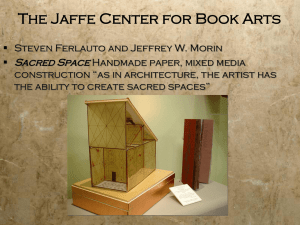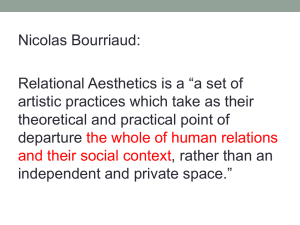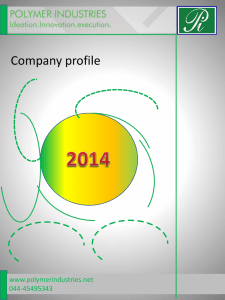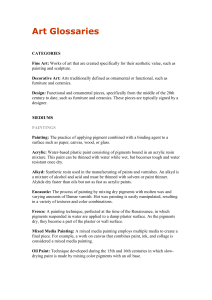The Art of Lifecasting
advertisement
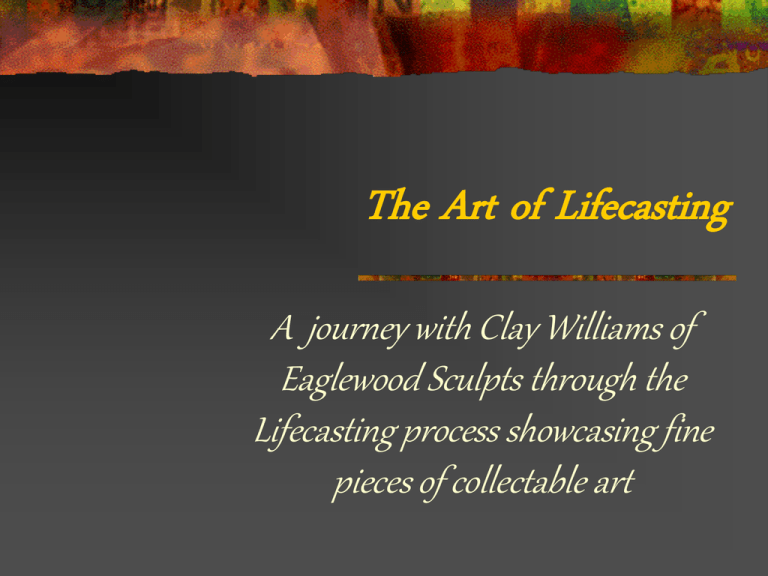
The Art of Lifecasting A journey with Clay Williams of Eaglewood Sculpts through the Lifecasting process showcasing fine pieces of collectable art What is a “Sculpture” “Sculpture is three-dimensional artwork created by shaping or combining hard materials, typically stone such as marble, metal, glass, wood, or plastic materials such as clay, textiles, polymers and softer metals. The term has been extended to works including sound, text and light. Found objects may be presented as sculptures. Materials may be worked by removal such as carving; or they may be assembled such as by welding , hardened such as by firing, or molded or cast. Surface decoration such as paint may be applied. Sculpture has been described as one of the plastic arts because it can involve the use of materials that can be moulded or modulated. Sculpture is an important form of public art” (Wikipedia 2010) Lifecasting Sculptures create the timeless beauty and eloquence of the classics using modern materials and techniques fused with the time honored methods of the masters. You are not limited by material or form, but by the boundaries of your own imagination. Lifecasting is not merely creating a mold and filling it with some material. It is an art in and of itself with the feelings and expressions of the artist coming through in the finished work. It does not try to diminish the works of the masters, but enhances and honors it. The artist combines various materials and techniques to achieve the end result It merges the new with the old and introduces to the person viewing the art piece a new realm of understanding for not only the human form, but for the passion and skill of the artist The expression and detail portrayed by the ancient sculptors is carried through into modern day. The same feeling and attention to what the artist succeeded in conveying in past centuries remains the standard for today's Lifecasting sculptors The Lifecasting artist of today uses many different things available to him as media, much as the ancient artist did in their era. The end result is enduring and timeless. Modern day Lifecasting sculptures are able to stand the test of time. They will be heirlooms to be handed down from generation to generation. They will be coveted items in many art circuits, prestigious galleries and many private collections. They are also offered as coveted awards for achievements in various fields. The Lifecasting Process The Lifecasting process, or Body Sculpting as we refer to it, is simple in theory, but also requires the expertise and talent of the artist to create a beautiful work of art. The main concern in the process is the comfort and relaxation of the subject. This is of utmost importance and proper care should be taken to address this properly. The first step in creating the piece is to merely sit and discuss the process and the vision of the work with the model and the artist. This can be simply walking thru the studio to see previous works, leafing thru the artists portfolio, touching and feeling the materials to be used, and simply understanding each others ideas and views of the work. Often it may be just simple conversation shared over a glass of wine or coffee, relaxing and knowing what to expect. The artist will explain in detail the entire process. He will decide which materials are to be used and examine various poses. He will walk the model through the steps involved and explain what needs to happen in each step. The process only requires anywhere from 30 minutes to 1 hour, depending on the material used and the position chosen and the complexity of the pose. Occasionally the process may be a bit longer. We start by selecting a post that is desired and making the model as comfortable as possible understanding that they will have to remain somewhat still for the duration of the process. The process of creating the mold begins by applying release agent if needed and then either the silicone or alginate material to the model. You must move quickly at this stage as there is limited time to apply the materials correctly to achieve a quality casting. After the initial molding material has been applied, you then apply the “Mother Mold” which will hold the shape of the models physique. This is usually either plaster bandages or other materials saturated with plaster. Without this phase the mold would not hold its shape and be useless, so this is a very critical component to a successful casting. The process can be fun and enjoyable for both the artist and the model. Comfort is first prority for the model. The artist should constantly ask how the model is feeling and make accommodations to be sure they are. After letting the plaster ”mother mold” dry, you remove it and the silicone mold. The Alginate type molds come off with the mother mold-they do not separate The models work is done!! After the mold is removed, you then apply layers of various materials. The selection is virtually endless what you can use, depending on the final location of the item and the finish desired. This is just the first step to creating a fine completed work. After the material has cured completely and you have the proper amount of layers applied, you remove the mold to expose the work for the first time. This is a very exciting stage of the process!! At this stage you see how good of a job you did on the mold. Take note of the detail that is captured down to the fine lines in the skin and even fingerprints. Now you have the rough form to begin creating your masterpiece You are only limited by your imagination on how you want the finished piece to look The finished sculpture is a fine piece of art suitable for gallery showing or just for private collections. The vision of the piece has far more impact than a mere photograph. It captures the essence of the model and freezes in time the memories that will endure for generations to come. Explore the creativity and desire of your imagination thru the lifecasting medium. If you are afraid to fail you will never succeed. When you need instruction or direction on how to get started, contact us and we will be happy to help and direct you Eaglewood Sculpts Artist/Sculptor Clay Williams Clay@eaglewoodsculpts.com 810-358-0209 www.eaglewoodsculpts.com Imlay City, MI


